First Mexican Republic
The First Mexican Republic, known also as the First Federal Republic (Spanish: Primera República Federal), was a federated republic, under the Constitution of 1824. It was nation-state officially designated the United Mexican States (Spanish: Estados Unidos Mexicanos, ![]()
United Mexican States Estados Unidos Mexicanos | |||||||||
|---|---|---|---|---|---|---|---|---|---|
| 1824–1835 | |||||||||
Motto: Religión, Independencia, Unión Religion, Independence, Union | |||||||||
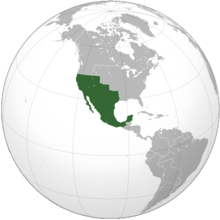 The United Mexican States in 1830 | |||||||||
| Capital | Mexico City | ||||||||
| Common languages | Spanish (official), Nahuatl, Yucatec Maya, Mixtecan languages, Zapotec languages | ||||||||
| Religion | Roman Catholicism | ||||||||
| Government | Federal Republic | ||||||||
| President | |||||||||
• 1824–1829 | Guadalupe Victoria (first) | ||||||||
• 1835 | Miguel Barragán (last) | ||||||||
| Vice President | |||||||||
• 1824–1827 | Nicolás Bravo | ||||||||
• 1829–1832 | Anastasio Bustamante | ||||||||
• 1833–1835 | Valentín Gómez Farías | ||||||||
| Legislature | Congress | ||||||||
| Senate | |||||||||
| Chamber of Deputies | |||||||||
| History | |||||||||
• Republic established | 1 November 1824 | ||||||||
| 4 October 1824 | |||||||||
| 23 October 1835 | |||||||||
| Population | |||||||||
• 1824[1] | 6,500,000 | ||||||||
• 1834[1] | 7,734,292 | ||||||||
| Currency | Mexican real | ||||||||
| ISO 3166 code | MX | ||||||||
| |||||||||
| Today part of | Mexico United States | ||||||||
The republic was proclaimed on November 1, 1823[5] by the Constituent Congress, months after the fall of the Mexican Empire ruled emperor Agustin I, a former royalist military officer-turned-insurgent for independence. The federation was formally and legally established on October 4, 1824 when the Federal Constitution of the United Mexican States came into force.[6]
It was bordered on the north by the United States and Oregon Country (or Columbia District); on the south and west by the Pacific Ocean; on the southeast by Central America, and the Caribbean Sea; and on the east by the Gulf of Mexico.[7] Although the region of Central America gained independence when Mexico did and was part of the territory of the Mexican Empire, it chose not to join Mexico's federated republic and was allowed to do so.
The Federal Republic lasted almost twelve years with constant struggles between the main political parties. The Conservatives, landowners, the army, the Catholic Church, and former monarchists sought a strong central government and a nation-state with an official religion. Liberals were republicans favoring a limited government power divided among the federated states and a secular nation. The conflict between these two competing visions of nationhood caused severe political instability and violence for the next 65 years, until the Porfiriato (1876-1911). "Independence transformed Mexico from Spain's largest and most prosperous colony to a sovereign nation suffering economic decline and political strife."[8]
The republic was ruled by two triumvirates and nine presidents. Insurgent general Guadalupe Victoria was the only president who completed his full term in this period and in almost 30 years of independent Mexico.[9] As in the early U.S., the president and vice president were elected separately and the men did not have to be of the same party. President Guadalupe Victoria was a liberal federalist, while his vice president, Nicolás Bravo, was a conservative centralist.[10] During the First Federal Republic army intervened in politics regularly, setting a pattern that lasted until the mid-twentieth century, with army generals predominantly serving as presidents of Mexico.
General Antonio López de Santa Anna repealed the Constitution of 1824 on October 23, 1835, and the Federal Republic became a unitary state, the Centralist Republic. The unitary regime was formally established on December 30, 1836, with the enactment of the seven constitutional laws.[11]
Independence and immediate aftermath
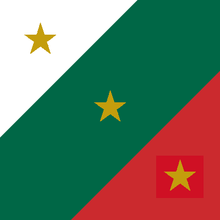
The Spanish overseas possession of the Viceroyalty of New Spain lasted for 300 years, from 1521 with the fall of the Aztec capital of Tenochtitlan and the foundation of Mexico City until the collapse of the viceroyalty in following years of civil war and military stalemate. An insurgency for independence from Spain lasted from the initial 1810 mass revolt, led by secular cleric Miguel Hidalgo and continued under another secular cleric, José María Morelos, and carried on the hot country of Mexico's south by Vicente Guerrero. Augustin Iturbide, a royalist military officer born in New Spain of Spanish parents, made a strategic alliance with insurgent leader Guerrero under the Plan of Iguala, in which the former foes fought in tandem to oust Spanish rule. The plan proclaimed Mexico a nation-state; Roman Catholicism as the sole religion; the equality of Spaniards those born in Mexico (Americanos), thereby abolishing colonial-era legal racial designations; and was to be a constitutional monarchy. The joint forces of the insurgent guerrillas and the royal army formed the Army of the Three Guarantees, and royal rule collapsed in New Spain. The incoming viceroy Juan O'Donojú signed the Treaty of Córdoba, recognizing New Spain's independence. Iturbide entered Mexico City in triumph on September 27, 1821. The new, independent nation-state was named the Mexican Empire.
Rise and fall of the First Mexican Empire
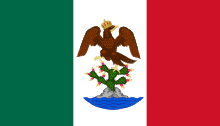
Elite American-born Spaniards in New Spain had no real experience with exercising political power other than on their city councils, so that monarchy was the familiar form of rule. No European of royal blood stepped in to assume the royal title in Mexico. A minority of the Constituent Congress in search of stability chose as monarch the general Agustín de Iturbide, who had led the war effort against Spain. He was proclaimed Emperor of Mexico on May 18, 1822. Political turmoil ensued, with Iturbide dissolving the Constituent Congress in October 1822 and jailing the legislators. Several members were jailed simply for expressing their disagreement with Iturbide. When Iturbide eliminated the elected Congress, he established an appointed National Board in its place. The dismissal of the Congress, the dictatorial style of government adopted by the Emperor, and the absence of solutions to the serious problems that the country was going through increased the conspiracies to change the imperial system.
The military men sent to crush the opposition instead proclaimed against Iturbide and issued the Plan of Casa Mata, which sought to create a new constituent assembly. Generals Antonio López de Santa Anna and Guadalupe Victoria drafted the Plan of Casa Mata in December 1822, which was proclaimed on 1 February 1823. It appealed to the political subdivisions of Mexico who sought local autonomy and home rule.[12] Several insurrections occurred in the Mexican provinces beginning in December, but they were all put down by the Imperial Army, except for Santa Anna's forces in Veracruz. Santa Anna had previously made a secret agreement with General Echávarri, the commander of the Imperial forces. By this agreement, the Plan of Casa Mata was to be proclaimed throughout Mexico on February 1, 1823, and Echávarri was to switch sides to join the insurgents. This plan did not recognize the First Mexican Empire and called for the convening of a new Constituent Congress. The insurrectionists sent their proposal to the provincial delegations and requested their adherence to the plan. In the course of just six weeks, the Plan of Casa Mata traveled to such remote places as Texas, and almost all the provinces supported the plan.
Antonio López de Santa Anna proclaimed the Plan of Casa Mata, which was later joined by Vicente Guerrero and Nicolás Bravo. Iturbide was forced to reinstate the Congress, and in a vain attempt to save the order and keep the situation favorable to his supporters, he abdicated on March 19, 1823. However, the restored Congress declared the appointment of Iturbide void ab initio, and thus refused recognition of the abdication. On 8 April, the Congress declared the Plan of Iguala and the Treaty of Córdoba void as well. With that the Empire was dissolved and the country declared its freedom to establish itself as it saw fit.
Provisional Government of Mexico (1823-1824)
The forced abdication of the emperor made the debate about how Mexico should constitute itself as a nation-state an urgent issue. It decided on a federated republic, which was the preferred form of government for most of Mexican provinces. The Bourbon Reforms of the eighteenth century had created administrative districts, intendancies, which decentralized power from the viceroy in Mexico City and empowered the intendants to communicate directly with the crown about their issues, rather than having Mexico City convey information. With this, provinces found themselves with a level of home rule that they were reluctant to give up when New Spain threw off Spanish rule and established the constitutional monarchy. With the end of that bridging period between Spanish monarchical rule and the Mexican monarchy, regions of Mexico sought to reassert their autonomy. For historian Timothy Anna, "the transition federal republic was the real 'revolution' because the old gave way to the new in Mexican history.”[13] In the period after abdication, Mexico opted to form a federal republic, much as the United States had already done (and later Canada did), a practical and workable solution "that allowed competent national government and an effective regional voice [which] was a delicate balancing act requiring frequent revision."[14]
1824 Constitution of Mexico
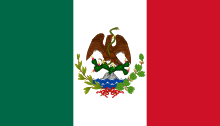
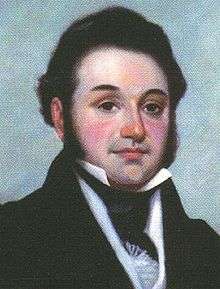
Following the abdication of Iturbide as emperor, a second constituent congress convened to draft a formal constitution. The Constitution of 1824 empowered regions of Mexico to assert their political power, resulting in a constitution that reinforced radical federalism, "with a weak national government fiscally dependent upon the states." It was weak foundation for the new sovereign state to confront challenges.[15] Conservatives who supported traditions rooted in the colonial order, especially centralized power of the state, were concerned about the framework of the strongly federalist constitution favored by most liberals. However, liberal intellectual José María Luis Mora lamented that Mexico, as well as other new Latin American republics established "solid governments." He opined "The reply is too easy: these [new republics] have not from adopted the representative system anything but the forms and its exterior apparatus. They have tried to unite intimately the despotic and miserable laws and customs of the old absolutism with the principles of a system in which all must be liberty and openness."[16]
Key elements of the constitution were:
- 1. The Mexican nation is sovereign and free from the Spanish government and any other nation.
- 3. The religion of the nation is the Catholic Church and is protected by law and prohibits any other.
- 4. The Mexican nation adopts as its form of government a popular federal representative republic.
- 6. The supreme power of the federation is divided into Legislative power, Executive power and Judiciary power.
- 7. Legislative power is deposited in a Congress of two chambers—a Chamber of Deputies and a Chamber of Senators.
- 50. Political freedom of press in the federation and the states (paragraph 1).
- 74. Executive power is vested in a person called the President of the United Mexican States.
- 75. It provides the figure of vice president, who in case of physical or moral impossibility of the president, exercise the powers and prerogatives of the latter.
- 95. The term of the president and vice president shall be four years.
- 123. Judiciary power lies in a Supreme Court, the Circuit Courts and the District Courts.
- 124. The Supreme Court consists of eleven members divided into three rooms and a prosecutor.
- 157. The individual state governments will be formed by the same three powers.
Creating new institutions
States had to create a functioning political system, which under the constitution was to have powers divided between the executive, legislative, and judicial branches. The new system had to grapple with creating a new legal system and deciding who was a citizen. The 1821 Plan of Iguala signaled a new direction for an independent Mexico, calling for the abolition of class distinctions and legal racial categories, while continuing traditional lack of equal standing for women. In the new federated republican era, equality before the law meant eliminating noble titles and special privileges (fueros) of particular groups. The result in theory leveled differences between classes. The transition from royal civil and criminal courts to a court system in the new order was not easy. Crown edicts no longer had force and new legal codes had not yet come into being. No one knew what laws were valid, there were vacancies in judgeships, and few trained lawyers. States were accorded the power over most civil and criminal legal matters. The separate court of the mostly Spanish merchants, the consulado, was abolished, but the military and ecclesiastical courts remained in place as part of their fuero.[17] For members of indigenous communities, the removal of colonial-era protections of their community lands and their access to the special General Indian Court made them more vulnerable in the new federated republican order.
Spain and Spaniards in Mexico
Although the last viceroy of New Spain signed the Treaty of Córdoba, Spain refused to recognize the loss of it valuable colony. Spanish military officers in Cuba, territory controlled by Spain, offered to mount a reconquest of Mexico. Spain still controlled the coastal fort of San Juan Ulúa until 1825. Spanish agents sought to assess the political situation in Mexico in the 1820s, looking for an opening to reassert control. "The Spanish government vacillated between planning military reconquest and seeking other means to achieve a negotiated return to Mexican dependency."
Many Spaniards did remain in Mexico after independence, but elite Mexicans viewed them warily, particularly those who had fought in the royalist army. This is despite the pledge of the Plan of Iguala and the Treaty of Córdoba guaranteeing equality between peninsular- and American-born Spaniards. All in Mexico were to be Mexican citizens, but with the question of the standing of the Spaniards was in doubt. There was strong anti-Spanish sentiment in the country, but expelling them challenged the tenets of liberal ideology, which stressed equality before the law. A leading liberal, José María Luis Mora, a diocesan priest and liberal intellectual, was opposed to Spaniards’ expulsion on ideological grounds, but also on practical grounds, since Spanish merchants had been vital to the flourishing of the colonial economy.[18]
In 1827, Mexico expelled remaining peninsular-born Spaniards, called disparagingly gachupines. In 1829, a Spanish expeditionary force was launched from Cuba, with the expectation that many Mexicans would support it. The Spaniards were wrong.[19]
Politics in the era of Guadalupe Victoria
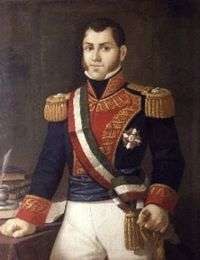
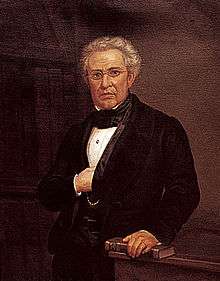
The lack of political experience of Mexican elites prior to independence and their sharply held opposing views meant that political life was both highly polarized and chaotic. Two leaders emerged, articulating the views of the two main political views. Lucas Alamán from the time he was a young man representing New Spain at the Cortes of Cádiz in 1812 until his death in 1853 was the voice of Mexican conservatism. Conservatives did not repudiate colonial-era institutions and sought a way to recreate what they considered the order and stability of that era, and were proponents of centralism, that is, a strong central government. Lorenzo de Zavala was the early voice of Mexican liberals was from Yucatán and emerged as a spokesperson for a Mexico that looked beyond the traditions and constraints of the colonial era, and were proponents of federalism, that is, for empowerment of states over the central government. The constitution of 1824 had enshrined federalism as its organizing principle, so that conservatives, who had supported Mexican independence but favored a strong central government, found themselves reviled as opponents of progress by the liberals.[20]
The first election immediately after the promulgation of the 1824 brought two heroes of independence to the fore as candidates. Guadalupe Victoria was considered a “natural choice” for the presidency. His opponent for the election was another hero of the insurgency, Nicolás Bravo. Both men ran restrained campaigns, and were, in fact, occupied with peacekeeping in the post-independence period. Bravo, however, signaled that he was opposed to the states’ rights of federalism and moved to protect Spaniards still in Mexico. Victoria won the indirect election, carrying all the northern states, most in favor of federalism. He served his entire four-year term, a feat not duplicated for decades. The fact that it lasted did not mean it was effective. It had no clear cut program of its own and was generally passive.[21]
Mexicans had no experience with electoral democracy, not least those considered their leaders. In the absence of a tradition of political parties, Mexican elites sorted themselves into rival rites of the Freemasons in the mid 1820s. Many conservatives, including Alamán, were affiliated with the Scottish Rite Masons, the elite group that was most sympathetic to the Spanish system. Many liberals, including Zavala and Vicente Guerrero, were affiliated with the York Rite Masons. The Yorkinos functioned as "the first political party for laboring people"[22] and became a vehicle to mobilize the popular classes, organizing them for political purposes. Since Masonic meetings were carried on in secret, politics took on the air of secrecy and conspiracy, but the Yorkinos in particular generated published propaganda, so that their views were widely disseminated throughout the country with the formation of Yorkino lodges.[23] Foreign interests became involved in Mexican politics through the rival Masonic lodges. Joel Roberts Poinsett, the U.S. government emissary to Mexico, involved himself in Masonic politics on the side of the Yorkinos, viewing them as most favorable to U.S. interests. The British envoy, Henry G. Ward and other British diplomats quietly worked with the Scottish Rite Mexican politicians.[24]
Pro-Spanish elements in Mexico sought the reinstatement of Spain's rule in Mexico. In January 1827, conspirators to bring that about were exposed and jailed, which led to the expulsion of Spaniards in December 1827. Other political agitation in the period saw the formulation of the Plan de Montaño in Tulancingo by Col. Manuel Montaño to dissolve "secret societies," in particular the Yorkinos, expel the U.S. Ambassador Joel Roberts Poinsett, who meddled in Mexican politics promoting the Yorkinos, and renovate the Victoria cabinet to displace Yorkinos who served in it. The legislature in Veracruz supported the plan. President Victoria put Vicente Guerrero in charge of combating the small group of armed elite rebels. Nicolás Bravo had joined the rebels and was captured, along with Montaño. Guerrero argued for leniency for Bravo, who was sent into exile. The Veracruz legislature was not dissolved, despite their support for the plan. The rebellion and the government's suppression of it discredited those who had wanted a centralist government with an authoritarian head of state. They were forced to moderate their stance for the time being and join with those opposing the country's populists led by Guerrero.[25]
Election of 1828
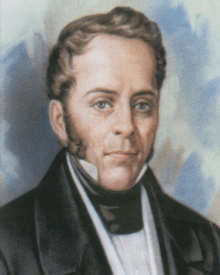
Presidential elections in Mexico were indirect, with state legislatures casting the votes for candidates. Unlike the election that brought Guadalupe Victoria to the presidency, the 1828 election saw that partisan conflicts of the new republic in raw form. Once again leaders from the war of independence stood for election, Vicente Guerrero, the insurgent leader of the south who had kept alive the idea of Mexican independence, and Manuel Gómez Pedraza, who had fought against the insurgents for independence and participated in the capture of José María Morelos. Other candidates were Anastasio Bustamante, Melchor Múzquiz, and Ignacio Godoy. Guerrero was a liberal, with a wide popular following. Gómez Pedraza was the choice of the conservatives, although he was a moderate and a Yorkino. The Masonic lodges that had come to prominence as the stand-ins for political parties during Guadalupe Victoria's presidency were mobilized during the 1828 election. However, there was no direct campaigning by candidates. Guerrero refrained from public speaking, in part because he was still suffering from the effects of a war wound in his chest, but more importantly so that those serving in state legislatures would not be dissuaded from voting for him because of his strong following in the popular classes. Guerrero's following came to be called the "People's Party," which supported broad male suffrage, support for decisions of municipalities, and support for federalism and against the power of Mexico City. Their campaign literature extolled his record as a hero of the insurgency.[26]
The opposition to Guerrero was not just politically conservative in its stance, but openly racist and raising fears about his mixed-race, black and mestizo followers. Carlos María Bustamante, the ideologue for Gómez Pedraza, raised the specter of Mexico becoming like Haiti, the former slave colony of France that overthrew European rule.[27]
Gómez Pedraza won the election, but under duress he renounced his victory on 3 December 1828 and went into exile. Liberal adversaries included General Antonio López de Santa Anna, who supported Guerrero. The election was annulled, and under the Plan de Perote, Vicente Guerrero assumed the presidency in 1829.
Presidency of Vicente Guerrero (1829)
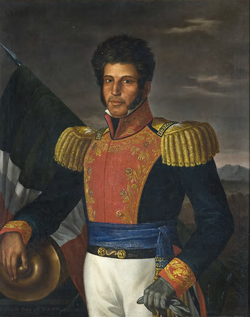
Guerrero became president on 1 April 1829, with conservative Anastasio Bustamante as his vice president. The legitimacy of Guerrero's presidency was in doubt from the beginning, since the 1828 election results were annulled under pressure of a liberal revolt, and Gómez Pedraza, the duly elected president, was forced to renounce office. Some traditional federalists leaders, who might have supported Guerrero, did not do so because of the electoral irregularities.[28] In his farewell speech from the presidency, Guadalupe Victoria cordially endorsed his old friend and fellow liberal insurgent Guerrero.[29] For Guerrero's supporters, a visibly mixed-race man from Mexico's periphery becoming president of Mexico was a step toward in what one 1829 pamphleteer called "the reconquest of this land by its legitimate owners" and called Guerrero "that immortal hero, favorite son of Nezahualcoyotzin", the famous ruler of prehispanic Texcoco.[30]
The nasty racial slurs and disparagement of his character in the campaign of 1828 did not let up when he assumed the presidency. In his inaugural address, he pointed to his long service to the nation fighting for independence, but also importantly to his holding of high office in independent Mexico. He said, "The representatives are to be found in all classes of the people, and the true titles of superiority, the only ones that cause distinction and preference, are discovered wherever talent and virtue appear."[31] In his first address to congress, he pledged that "the administration is obliged to procure the widest possible benefits and apply them from the palace of the rich to the wooden shack of the humble laborer." He went on to extol liberal values of equality before the law and rewards for those with talent and virtue.[32]
The national treasury was empty and future revenues were already liened. Spain continued to deny recognition of Mexico's independence and threatened reconquest. Guerrero's supporters were strongly anti-Spanish and there had already been one order for their expulsion under the Victoria government. Guerrero called for the establishment of public schools, which would give access to education of Mexico's popular classes. In the colonial era, education was exclusively in the hands of the Catholic Church and the main beneficiaries were elite men. Guerrero also called for land title reforms, industry and trade development, and other programs of a liberal nature. Now president, Guerrero championed the causes of the racially oppressed and economically oppressed. He ordered an immediate abolition of slavery on September 16 of 1829. In central Mexico, there were few black slaves, so that the gesture was largely symbolic, but in the Mexican state of Texas, where Anglo-American slave-holding southerners were colonizing, the decree went against their economic interests.[33]
During Guerrero's presidency, the Spanish tried to reconquer Mexico, but they failed, being defeated at the Battle of Tampico.
Church-State relations
The Spanish monarchy had the full power to appoint clerics in its overseas possessions through the papal grant of the Patronato Real. When Mexico obtained its independence, Roman Catholicism continued to be the only permissible faith. However, the question of the power of appointment of clerics was highly contested. The Mexican government asserted that the right passed to the new national government, in what was termed the Patronato nacional. With Spain not recognizing Mexico's independence, the papacy claimed that the patronato reverted to itself, the original grantor. The Spanish crown had systematically replaced elite American-born Spaniards in positions in the civil and religious spheres, so that anti-Spanish sentiment now fell on Spanish clerics. When Mexico expelled peninsular-born Spaniards in 1827, many bishops and other members of the ecclesiastical hierarchy left, leaving all high church positions vacant until 1840. The lack of bishops and parish priests meant that the connection between Mexican Catholics and the institution of the church was damaged, weakening its authority and its influence among the vast number of poor parishioners. During the early 1830s, under vice president Valentín Gómez Farías, the Mexican state undertook an early reform of church-state relations, with the backing of Mexican liberals. The missions in the northern regions were secularized and their resources confiscated, the educational system, previously in the hands of the Church, was secularized; the state ceased collecting tithes, a 10% tax on agricultural output, on behalf of the church, and declared monastic vows were no longer binding. President Antonio López de Santa Anna reasserted his role as head of state and cancelled the anti-clerical measures, but they were a precursor to the mid-nineteenth-century liberal Reform.[34]
Conflicts with Indigenous peoples in Northern Mexico
In Alta California during the late colonial era the Franciscans had established missions from San Diego in the south to the San Franciscan bay area in the north. In 1824, indigenous in four central coast missions revolted against ill-treatment by non-indigenous authorities. The Chumash revolt was suppressed, the mission indigenous pardoned and urged to return to the missions, but the revolt was serious and challenged the narrative of peaceful mission indigenous. [35]
The republic would largely adopt Spanish colonial policy with regard to the Apache, establicimiento, or the system by which the Spanish sought to settle the Apache and make them sedentary by offering these Apaches de Paz (Peaceful Apaches) goods and land in exchange for peace and abandonment of nomadic lifestyle.[36] The Mexican state followed the practice of its Spanish colonial predecessor, with inadequate military resources to suppress the northern indigenous groups that did not recognize outsiders sovereignty over their territory. Mexico faced an insufficient defense network against the Comanches and Apaches in the Northern States.[37] Even going so far as to include a royal signature, pre-Republican Mexico reinstated Spanish Indian policies to the letter. While some peace treaties did exist between locals and los indios, the peace did not last long, as Apaches would often simply take their violence elsewhere when villages proved to be too difficult to raid.[37] With these ineffective policies in place, combined with an ever-evolving and adapting Comanche Empire,[38] the Early Republic faced a formidable foe with an inadequate infrastructure. The lack of appropriate defense against raids might not have been so large of a problem for the Republic, if establicimiento had not all but been forgone by the 1830s, with post-independence 1820s economic instability causing many regions to drastically reduce rations to the Apaches de Paz.[37]
The Apache were supplied with guns by US American merchants.[37] Goods including guns and shoes were sold to the Apache, the latter being discovered by Mexican forces when they found traditional Apache trails with American shoe prints instead of moccasin prints.[37] The cycle of heightened violence between Mexicans and Apaches further destabilized the Republic, with bloody and violent suppression of Apaches.[37] Discontent among the northern Mexican states reached a peak in 1837, when the governor of the Sonora declared that "the United States has already as much as declared a state of war between our two nations" with regard to both the annexation of Texas and the illegal enterings/selling of weapons committed by United States' citizens.[37]
End of the First Mexican Republic
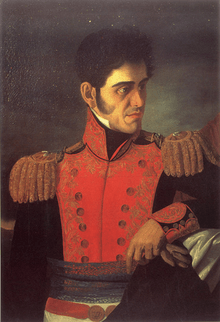
Under Mexican army General Antonio López de Santa Anna, a former federalist turned centralist and eventual dictator, the conservative forces in Mexico suspended the 1824 Constitution and replaced it with the Siete Leyes ("Seven Laws") in 1835. The Seven Laws transformed the federated republic into a unitary state known as the Centralist Republic of Mexico.
Several states openly rebelled against these changes. Northern Coahuila y Tejas, San Luis Potosí, Querétaro, Durango, Guanajuato, Michoacán, Yucatán, Jalisco, Nuevo León, Tamaulipas, and Zacatecas all disapproved. Civil war quickly spread across the Mexican states, and three new governments declared independence: the Republic of Texas, the Republic of the Rio Grande and the Republic of Yucatán. The Texas Revolution was already underway when the Siete Leyes came into force, and the new powers of the Mexican central government were yet another grievance for their movement.
Notes
- Evolución de la Población de México durante los años de 1521 al 2000
- Romo, Rafael (November 23, 2012). "After nearly 200 years, Mexico may make the name official". CNN.
- "About Mexico". Embajada de Mexico en Estados Unidos (Mexican Embassy in the United States). December 3, 2012. Archived from the original on December 2, 2013. Retrieved July 17, 2013.
- "Official name of the country". Presidency of Mexico. March 31, 2005. Retrieved May 30, 2010.
- "Acta Constitutiva de la Nación Mexicana". 500 años de México en documentos. Retrieved January 24, 2016.
- "Decreto. Constitución federal de los Estados-Unidos Mexicanos". 500 años de México en documentos. Retrieved January 22, 2015.
- Merriam-Webster's Geographical Dictionary, 3rd ed., Springfield, Massachusetts, USA, Merriam-Webster; p. 733
- Stevens, Donald Fithian. Origins of Instability in Early Republican Mexico. Duke University Press 1991, p. 1.
- "How the First President of the United Mexican States came into office" (PDF) (in Spanish and English). 500 años de México en documentos. Archived from the original (PDF) on July 3, 2011. Retrieved July 4, 2015.
- Bazant, Jan. "From independence to the Liberal Republic, 1821-1867" in Mexico Since Independence, Leslie Bethell, ed. Cambridge: Cambridge University Press 1991, p. 9.
- "Se transita del federalismo al centralismo mediante las Bases de Reorganización de la Nación Mexicana". 500 años de México en documentos. Retrieved January 24, 2016.
- Rodríguez O., Jaime, "Plan of Casa Mata", in Encyclopedia of Latin American History and Culture, vol. 2, p. 1. New York: Charles Scribner's Sons 1996.
- Anna, Timothy Forging Mexico, 1821-1835. University of Nebraska Press 1998, p. x
- <Anna, Forging Mexico, p. xi
- Josefina Zoraida Vázquez, "War and Peace with the United States." p. 341.
- quoted in Hale, Mexican Liberalism, p. 105.
- Green, The Mexican Republic: The First Decade pp. 70-71.
- Charles A. Hale, Mexican Liberalism in the Age of Mora. New Haven: Yale University Press 1969 pp. 100-101.
- Christon Archer, "Fashioning a New Nation", pp. 318-19.
- Green, The Mexican Republic, p.50
- Green, The Mexican Republic, p. 141.
- Vincent, The Legacy of Vicente Guerrero, p. 154.
- Green, The Mexican Republic, pp. 87-89
- Green, The Mexican Republic, p. 66.
- Vincent, The Legacy of Vicente Guerrero, pp. 157-58
- Vincent, The Legacy of Vicente Guerrero, p. 159.
- Vincente, The Legacy of Vicente Guerrero, pp. 159-69
- Green, The Mexican Republic, pp. 162–63.
- Vincent, The Legacy of Vicente Guerrero, p. 179.
- Quoted in Hale, Charles A. Mexican Liberalism in the Age of Mora. New Haven: Yale University Press 1968. p. 224.
- Vincent, The Legacy of Vicente Guerrero, p. 177.
- Vincent, The Legacy of Vicente Guerrero, p. 178.
- Sprague, William Forrest. "Coahuila y Texas Under President Vicente Guerrero". TAMU. Archived from the original on 16 August 2007. Retrieved 6 June 2010.
- Timothy J. Henderson, "Church and State, 1821-1910" in Encyclopedia of Mexico, pp. 253-54.
- Beebe, Rose; Senkewicz, Robert (2001). Lands of Promise and Despair: Chronicles of Early California, 1535-1846. Santa Clara: Santa Clara University. ISBN 1-890771-48-1.
- Matthew, Babcock (2016-09-26). Apache adaptation to Hispanic rule. ISBN 9781107121386. OCLC 962258260.
- 1965-, Jacoby, Karl (2008-01-01). Shadows at dawn : a borderlands massacre and the violence of history. Penguin Press. ISBN 9781594201936. OCLC 682097186.CS1 maint: numeric names: authors list (link)
- Tutino, John. 2013. "4. Globalizing the Comanche empire." History & Theory 52, no. 1: 67-74. Academic Search Premier, EBSCOhost (accessed April 21, 2017).
Further reading
- Anna, Timothy. "Demystifying Early Nineteenth-Century Mexico. Mexican Studies 9, no. 1 Winter 1993, 119-37.
- Anna, Timothy. Forging Mexico, 1821-1835. Lincoln: University of Nebraska Press 1998. ISBN 0803259417
- Anna, Timothy. "Inventing Mexico: Provincehood and Nationhood after Independence." Bulletin of Latin American Research 15, no. 1 (Jan. 1996), 7-17.
- Anna, Timothy. "Iturbide, Congress, and Constitutional Monarchy in Mexico," In The Political Economy of Spanish America in the Age of Revolution, 1750-1850, ed. Kenneth J. Andrien and Lyman L. Johnson, 17-38. Albuquerque: University of New Mexico Press 1994.
- Archer, Christon. "Fashioning a New Nation." In The Oxford History of Mexico, Michael C. Meyer and William H. Beezley. New York, Oxford University Press 2000. ISBN 0195112288
- Bazant, Jan. "From Independence to the Liberal Republic, 1821-1867" in Mexico Since Independence. Leslie Bethell, ed. Cambridge: Cambridge University Press 1991, pp. 1-48.
- Costeloe, Michael P. La Primera República Federal de México, 1824-1835. Mexico: Fondo de Cultura Económica 1975.
- Green, Stanley C. The Mexican Republic: The First Decade, 1823-1832. ISBN 0822938170 Pittsburgh: University of Pittsburgh Press 1987.
- Guardino, Peter. "Barbarism or Republican Law? Guerrero's Peasants and National Politics, 1820-1846." Hispanic American Historical Review 75, no. 2 (May 1995): 185-213.
- Guedea, Virginia. "The Old Colonialism Ends, the New Colonialism Begins." In The Oxford History of Mexico, Michael C. Meyer and William H. Beezley. New York, Oxford University Press 2000. ISBN 0195112288
- Hale, Charles A.. Mexican Liberalism in the Age of Mora. New Haven: Yale University Press 1968.
- Jaques, Tony, ed. (2007), Dictionary of Battles and Sieges: A Guide to 8,500 Battles from Antiquity through the Twenty-first Century (3 volumes ed.), Greenwood Publishing Group, ISBN 978-0-313-33536-5CS1 maint: ignored ISBN errors (link)
- Stevens, Donald Fithian. Origins of Instability in Early Republican Mexico. Duke University Press 1991. ISBN 0822311364
- Tenenbaum, Barbara, The Politics of Penury: Debts and Taxes in Mexico, 1821-1856. Albuquerque: University of New Mexico Press 1986. ISBN 0826308902
- Vázquez, Josefina Zoraida. "War and Peace with the United States." In The Oxford History of Mexico, Michael C. Meyer and William H. Beezley. New York, Oxford University Press 2000. ISBN 0195112288
- Vincent, Theodore G. The Legacy of Vicente Guerrero, Mexico's First Black Indian President. University of Florida Press 2001. ISBN 0813024226
